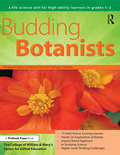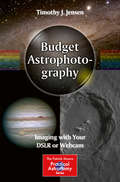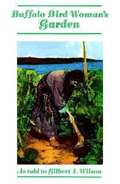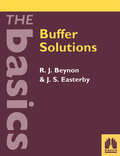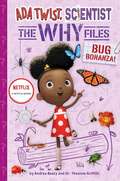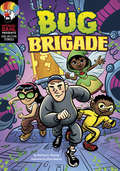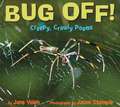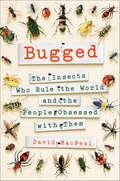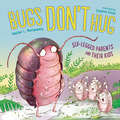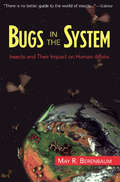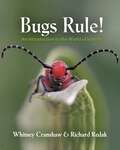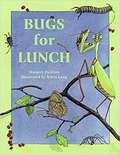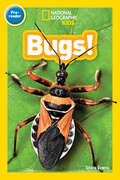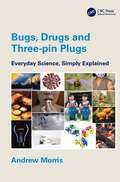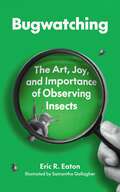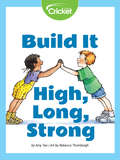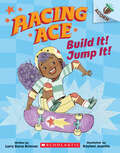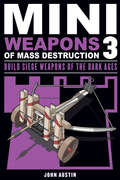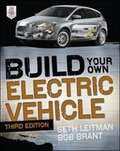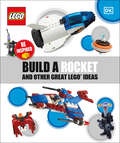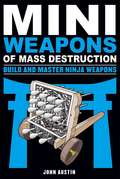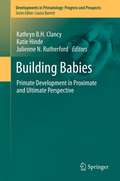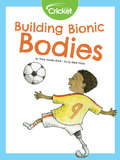- Table View
- List View
Budding Botanists: A Life Science Unit for High-Ability Learners in Grades 1-2
by Clg Of William And Mary/Ctr Gift EdBudding Botanists, a life science unit for grades 1-2, engages students in an investigation of plant life as they assume the role of botanists. Team members seek to understand the structure, nature, and life cycle of plants, and to answer questions such as “How can plants be used to fuel cars?”Winner of the 2008 NAGC Curriculum Studies Award, Budding Botanists was developed by the Center for Gifted Education at The College of William and Mary, to offer advanced curriculum supported by years of research. The Center's materials have received national recognition from the United States Department of Education and the National Association for Gifted Children, and they are widely used both nationally and internationally.Each of the books in this series offers curriculum that focuses on advanced content and higher level processes. The science units contain simulations of real-world problems, and students experience the work of real science by using data-handling skills, analyzing information, and evaluating results. The mathematics units provide sophisticated ideas and concepts, challenging extensions, higher order thinking skills, and opportunities for student exploration based on interest. These materials are a must for any teacher seeking to challenge and engage learners and increase achievement.Grades 1-2
Budget Astrophotography: Imaging with Your DSLR or Webcam (The Patrick Moore Practical Astronomy Series)
by Timothy J. JensenHere are clear explanations of how to make superb astronomical deep-sky images using only a DSLR or webcam and an astronomical telescope - no expensive dedicated CCD cameras needed! The book is written for amateur astronomers interested in budget astrophotography - the deep sky, not just the Moon and planets - and for those who want to improve their imaging skills using DSLR and webcams. It is even possible to use existing (non-specialist astronomical) equipment for scientific applications such as high resolution planetary and lunar photography, astrometry, photometry, and spectroscopy. The introduction of the CCD revolutionized astrophotography. The availability of this technology to the amateur astronomy community has allowed advanced science and imaging techniques to become available to almost anyone willing to take the time to learn a few, simple techniques. Specialized cooled-chip CCD imagers are capable of superb results in the right hands - but they are all very expensive. If budget is important, the reader is advised on using a standard camera instead. Jensen provides techniques useful in acquiring beautiful high-quality images and high level scientific data in one accessible and easy-to-read book. It introduces techniques that will allow the reader to use more economical DSLR cameras - that are of course also used for day-to-day photography - to produce images and data of high quality, without a large cash investment.
Buffalo Bird Womans Garden: Agriculture of the Hidatsa Indians
by Jeffery R. Hanson Gilbert L. WilsonFrom the book: Buffalo Bird Woman, known in Hidatsa as Maxidiwiac, was born about 1839 in an earth lodge along the Knife River in present-day North Dakota. In 1845 her people moved upstream and built Like-a-fishhook village, which they shared with the Mandan and Arikara. There Buffalo Bird Woman grew up to become an expert gardener of the Hidatsa tribe. Using agricultural practices centuries old, she and the women of her family grew corn, beans, squash, and sunflowers in the fertile bottomlands of the Missouri River. In the mid-1880s, U.S. government policies forced the break up of Like-a-fishhook village and the dispersal of Indian families onto individual allotments on the Fort Berthold Reservation, but Hidatsa women continued to grow the vegetables that have provided Midwestern farmers some of their most important crops. In Buffalo Bird Woman's Garden, first published in 1917 as Agriculture of the Hidatsa Indians: An Indian Interpretation, anthropologist Gilbert L. Wilson transcribed in meticulous detail the knowledge given by this consummate gardener. Following an annual round, Buffalo Bird Woman describes field care and preparation, planting, harvesting, processing, and storing of vegetables. In addition, she provides recipes for cooking traditional Hidatsa dishes and recounts songs and ceremonies that were essential to a good harvest. Her first-person narrative provides today's gardener with a guide to an agricultural method free from fertilizers, pesticides, and herbicides. ... Squash Dolls There is one other thing I will tell before we forsake the subject of squashes. Little girls of ten or eleven years of age used to make dolls of squashes. When the squashes were brought in from the field, the little girls would go to the pile and pick out squashes that were proper for dolls. I have done so, myself. We used to pick out the long ones that were parti-colored; squashes whose tops were white or yellow and the bottoms of some other color. We put no decorations on these squashes that we had for dolls. Each little girl carried her squash about in her arms and sang for it as for a babe. Often she carried it on her back, in her calf skin robe. ... This is a most fascinating read whether or not one likes to garden.
Buffer Solutions (THE BASICS (Garland Science))
by Professor Rob Beynon J EasterbyAn indispensable guide to buffers and to understanding the principles behind their use. Helps the user to avoid common errors in preparing buffers and their solutions.A must for researchers in the biological sciences, this valuable book takes the time to explain something often taken for granted - buffers used in experiments. It answers the common questions such as: which buffer should I choose? What about the temperature effects? What about ionic strength? Why is the buffer with the biggest temperature variation used in PCR? It provides even the most experienced researchers with the means to understand the fundamental principles behind their preparation and use - an indispensable guide essential for everyone using buffers.
Bug Bonanza! (Questioneers)
by Andrea Beaty Theanne GriffithBug Bonanza! is the fourth book in a nonfiction early-reader series about simple science concepts starring Ada Twist, Scientist, spun-off from Andrea Beaty’s New York Times bestselling Questioneers series and the hit Netflix show—cowritten by neuroscientist Dr. Theanne Griffith. <P><P> How do bees fly? Why does a spider weave a web? And why are bugs so important to our world? Ada Twist, Scientist: The Why Files is the perfect nonfiction resource for all these questions pondered by the youngest scientists of tomorrow, as they learn along with Ada. Designed in a scrapbook format, these books combine art from the Netflix show, illustrations, and photography to bring simple science concepts to life.
Bug Brigade (Michael Dahl Presents: Side-Splitting Stories)
by Matthew K. ManningThey're the world's greatest heroes! The grim avengers of the night! The planet's first line of defense against supervillains and alien threats! They're . . . the Bug Brigade? Doug, Josie, Kira, and Reginald were all normal sixth graders at the start of their field trip to the Blue Mountain Science Museum. Proud members of the Bug Society of Littleton, the friends are thrilled to explore a private wing of the museum where they can learn all about their favorite insects. But when they get mixed up in a scientist's experiment involving radioactive bugs, they find themselves in over their heads (and antennas!). The Bug Brigade must swarm together to fight off an evil insect villain. Will their newfound buggy superpowers be up to the test?
Bug Off!: Creepy, Crawly Poems
by Jane Yolen Jason StempleIn Bug Off! readers meet thirteen bugs in playful, humorous poems and startling, intimate photographs. Nonfiction prose paragraphs broaden the perspective: Children will learn how bees make honey, that many butterflies can taste food with their feet, that lovebugs can fly higher than the Empire State Building, and much more. The subjects will be familiar to kids—a fly, praying mantis, honeybee, butterfly, daddy longlegs, lovebug, dragonfly, tick, ladybug, spider, grasshopper, ants, and a swarm of bugs—but the poems, photographs, and nonfiction passages present them in eye-opening new ways. Includes an author's note that encourages readers to write their own bug poems.
Bugged: The Insects Who Rule the World and the People Obsessed with Them
by David MacNeal"Creepy, beautiful, icky and amazing." —Penny Le Couteur, author of Napoleon's ButtonInsects have been shaping our ecological world and plant life for over 400 million years. In fact, our world is essentially run by bugs—there are 1.4 billion for every human on the planet. In Bugged, journalist David MacNeal takes us on an off-beat scientific journey that weaves together history, travel, and culture in order to define our relationship with these mini-monsters. MacNeal introduces a cast of bug-lovers—from a woman facilitating tarantula sex and an exterminator nursing bedbugs (on his own blood), to a kingpin of the black market insect trade and a “maggotologist”—who obsess over the crucial role insects play in our everyday lives. Just like bugs, this book is global in its scope, diversity, and intrigue. Hands-on with pet beetles in Japan, releasing lab-raised mosquitoes in Brazil, beekeeping on a Greek island, or using urine and antlers as means of ancient pest control, MacNeal’s quest appeals to the squeamish and brave alike. Demonstrating insects’ amazingly complex mechanics, he strings together varied interactions we humans have with them, like extermination, epidemics, and biomimicry. And, when the journey comes to an end, MacNeal examines their commercial role in our world in an effort to help us ultimately cherish (and maybe even eat) bugs.
Bugs Don't Hug: Six-Legged Parents and Their Kids
by Heather L. MontgomeryMeet the mamas and papas of the insect world in this fresh and funny nonfiction look at how bugs are like us from popular science author and teacher Heather Montgomery.Most insects don't take care of their young, but some do--in surprising ways. Some bugs clean up after their messy little ones, cater to their picky eaters, and yes--hug their baby bugs. A fun and clever look at parenting in the insect world, perfect for backyard scientists and their own moms and dads. Back matter includes further information about the insects and a list of resources for young readers.
Bugs In The System: Insects And Their Impact On Human Affairs
by May R. BerenbaumAn introduction to insect physiology, genetics and behaviour which looks at the interaction between humans and insects, and explores both the positive and negative aspects of the relationship.
Bugs Rule!: An Introduction to the World of Insects
by Richard Redak Whitney CranshawThe essential illustrated introduction to insects for nonscience majorsBugs Rule! provides a lively introduction to the biology and natural history of insects and their noninsect cousins, such as spiders, scorpions, and centipedes. This richly illustrated textbook features more than 830 color photos, a concise overview of the basics of entomology, and numerous sidebars that highlight and explain key points. Detailed chapters cover each of the major insect groups, describing their physiology, behaviors, feeding habits, reproduction, human interactions, and more.Ideal for nonscience majors and anyone seeking to learn more about insects and their arthropod relatives, Bugs Rule! offers a one-of-a-kind gateway into the world of these amazing creatures.Places a greater emphasis on natural history than standard textbooks on the subjectCovers the biology and natural history of all the insect ordersProvides a thorough review of the noninsect arthropods, such as spiders, scorpions, centipedes, millipedes, and crustaceansFeatures more than 830 color photosHighlights the importance of insects and other arthropods, including their impact on human societyAn online illustration package is available to professors
Bugs for Lunch (Fountas & Pinnell LLI Blue #Level J)
by Margery Facklam Sylvia LongDiscover the variety of bug-eaters—animal, plant, even human—in this exploration of both poetry and the natural world. Facklam’s playful rhymes mixed with Long’s vivid illustrations introduce young readers to an array of creatures as they munch on lunch. From a mantis perched and ready to prey on ladybugs, a spider trapping a fly, to the honey-drenched fur of a big brown bear chewing on a hive full of bees, Bugs for Lunch will give curious readers plenty of food for thought delivered in a playful package.
Bugs of the World: 250 Creepy-Crawly Creatures from Around Planet Earth
by Francesco TomasinelliFrom moths and beetles to worms and spiders, this completely illustrated, fact-filled book features hundreds of creepy-crawlies for kids to discover and explore.This gorgeously illustrated book reveals the hidden world of some of the most mind-boggling insects. Divided into categorical sections like herbivores and predators, Bugs of the World includes beetles, wasps, bees, ants, caterpillars, butterflies, dragonflies, spiders, flies, crickets and grasshoppers, centipedes and millipedes, and more. Each of the 250 insects featured is accompanied by beautiful illustrations and facts about the creature, including its common name and scientific name, its size, its continent of origin, and a brief description of its unique characteristics. Kids will also learn about the different life cycles of insects, why they are important to ecology and our world, the planet's most dangerous insects, how bugs camouflage themselves, and so much more.
Bugs! (Readers)
by Shira EvansYoung readers learn all about insects in this new Pre-reader from National Geographic Kids.Through text features such as a vocabulary tree and wrap-up activity, kids will be introduced to vocabulary in concept groups, helping them make connections between words and expand their understanding of the world. Along with brilliant photos and a fun approach to reading, National Geographic Readers are a winning formula with kids, parents, and educators.
Bugs, Drugs and Three-pin Plugs: Everyday Science, Simply Explained
by Andrew MorrisFor the millions who remain curious about the world around them, but gained little from science at school, this book offers a way forward. Based on live discussions with adults from all walks of life, each chapter begins with an everyday experience, like swallowing a pill or watching a bee on a flower. The main scientific ideas underlying each topic are then explored, so that understanding of a set of fundamental concepts builds up gradually throughout the book. In contrast to more traditional approaches to science learning, topics range freely across the subject areas. The story of Covid, for example includes aspects of biology, chemistry, mathematics and social behaviour. Plain English is used throughout and mathematical expressions are avoided. Key points are illustrated with clear diagrams and photographs. By drawing on questions and perspectives of ordinary people, the book offers an introduction to basic ideas in science as a whole, rather than any one particular subject. For the adult wishing to make good a gap in their understanding it provides a starting point for entering the rich world of popular science.
Bugwatching: The Art, Joy, and Importance of Observing Insects
by Eric R. EatonDiscover the pleasures of watching insects with this fun, informative, and marvelously illustrated how-to guideInsects are the most abundant wildlife on the planet—but also the least observed. This incisive field companion highlights the basic tools for watching insects with all of our senses, covers some best habitats and circumstances for seeing the most diversity, and shares tips for attracting desirable insects to your yard and garden. With wonderful illustrations by Samantha Gallagher, Bugwatching explains why this rewarding activity is for everyone, regardless of age, ethnicity, gender identity, level of affluence, ability, or disability. When you become a bugwatcher, you join a community of supportive and energetic people. The potential for personal and scientific discovery is virtually limitless.Enables you to better appreciate and understand insects and improve your success rate in finding, watching, and identifying themIncludes a comprehensive treatment of insect behaviors that is invaluable for beginnersDiscusses social bugwatching and participation in community science projectsCovers advanced topics such as rearing insects and using keys to identify themExplains how watching insects can fill gaps in our knowledge about their economic impacts and the growing decline in insect diversity and abundancePromotes safety, accessibility, and inclusion as vital aspects of watching insectsAn essential guide for seasoned bugwatchers and newcomers to the community
Build It High, Long, Strong
by Amy TaoHave you ever wondered how tall and long bridges are built? Learn about three different bridges and try the activities to learn about how strong bridges, like the Golden Gate Bridge, are made.
Build It! Jump It!: An Acorn Book (Racing Ace)
by Larry Dane BrimnerAce builds a cool skateboard and learns how to skate in this fast-paced, STEM-themed early reader!Pick a book. Grow a Reader!This series is part of Scholastic's early reader line, Acorn, aimed at children who are learning to read. With easy-to-read text, a short-story format, plenty of humor, and full-color artwork on every page, these books will boost reading confidence and fluency. Acorn books plant a love of reading and help readers grow!Ace works hard to build a skateboard. She tightens every nut and bolt -- and adds a cool sticker. Then, Ace is ready to skate. But Ace goes too fast and falls down! She will have to try again. Will Ace ever be able to rocket up the ramp?With Larry Dane Brimner's simple text and Kaylani Juanita's full-color artwork on every page, this action-packed book is perfect for new readers!
Build Siege Weapons of the Dark Ages: Build Siege Weapons of the Dark Ages (Mini Weapons of Mass Destruction #3)
by John AustinUtilizing easy-to-find and inexpensive materials, this handy resource teaches desktop warriors how to build a multitude of medieval siege weapons for the modern era. Novice combatants will learn to build 35 defense weapons, including a marshmallow catapult, a chopstick bow, a bottle cap crossbow, and a clothespin ballista. In addition to beefing up their Dark Age arsenal, would-be warriors are provided with a number of targets on which to practice their shooting skills. Clear diagrams, instructions, and safety tips for each project are included, making construction of each of these weapons simple, safe, and fun.
Build Your Own Electric Vehicle (Build Your Own)
by Seth Leitman Bob BrantBUILD, CONVERT, OR BUY A STATE-OF-THE-ART ELECTRIC VEHICLE: Thoroughly revised and expanded, Build Your Own Electric Vehicle, Third Edition, is your go-to guide for converting an internal combustion engine vehicle to electric or building an EV from the ground up. You'll also find out about the wide variety of EVs available for purchase and how they're being built. This new edition details all the latest breakthroughs, including AC propulsion and regenerative braking systems, intelligent controllers, batteries, and charging technologies. <p><p> Filled with updated photos, this cutting-edge resource fully describes each component--motor, battery, controller, charger, and chassis--and provides illustrated, step-by-step instructions on how to assemble all the parts. Exclusive web content features current supplier and dealer lists. Custom-built for environmentalists, engineers, students, hobbyists, and mechanics, this hands-on guide puts you in the fast lane toward a cost-effective, reliable green machine. <p><p> This Third Edition, covers: Environmental impact and energy savings, The best EV for you--purchase trade-offs, conversion trade-offs, and conversion costs, Chassis and design, Different types of electric motors and controllers, Lithium EV batteries, Chargers and electrical systems, EV builds and conversions, Licensing and insuring your EV, Driving and maintenance, List of manufacturers and dealers regularly updated on website.
Build a Rocket and Other Great LEGO Ideas
by DKThis bite-size collection of space-themed LEGO ideas will launch you into a whole new world of creativity.Small in size but big in inspiration, this neat 32-page volume contains a collection of projects from the 'Out of This World' chapter of The LEGO® Ideas Book. These ideas will do more than teach building skills; they will unlock your imagination and get you dreaming up dozens of ideas of your own. And of course, every one of them is great fun. Building that LEGO rocket is a must, but you'll need jet packs, spacewalkers, and moon miners for exploring alien planets. And then there's the aliens themselves, plus their stealth ships and flying saucers. There's all this and lots more inside this book, so dip in - and don't forget, there are four other exciting books in this series, too.©2020 The LEGO Group
Build and Master Ninja Weapons (Mini Weapons of Mass Destruction #4)
by John AustinAuthor and toy designer John Austin provides detailed, step-by-step instructions with diagrams to show stealth warriors how to build 37 different ninja weapons for the modern era. Each of the projects in MiniWeapons of Mass Destruction 4 are built from common household and office items--plastic utensils, markers, clothespins, paper clips, wire hangers, and discarded packaging--all clearly detailed on materials lists. Builders are offered a variety of samurai stars, blowguns, throwing darts, siege weapons, and ninja tools to choose from. Once they've assembled their armory, the author provides novices several targets to construct to practice their shooting skills. Armed, trained, and shrouded in black, readers are now prepared for missions of reconnaissance, sabotage, and other grim errands
Build!
by Red Nose StudioFor all young truck lovers and fans of books like Goodnight, Goodnight, Construction Site! Watch a series of amazing construction vehicles—a dump truck, a bulldozer, and many others—build a building unlike any other. Then delight in the surprise ending, where young readers and listeners can see that the trucks are actually toys that a little boy is playing with!Bulldozers, dump trucks, and cranes are just a few of the vehicles working together in these pages to build something incredible. The payloader makes the hole for the foundation ("DIG"), the semi-loader brings in the huge blocks ("HAUL"), and the crane lifts them up ("HOIST"). But is this a real construction site, or a boy's backyard? And after the structure is done, what happens next? Yes, the inevitable: he makes it all tumble down and is ready to start all over again! Here is an ingenious book that showcases all kinds of trucks and celebrates the joy of imaginative play. But it is also a marvel of ingenuity on the part of Red Nose Studio, who has hand-built each of the trucks, as well as the construction site, then photographed his 3-D creations. As added value, the inside of the jacket—which pictures each vehicle and a simple description of what it does—can be hung in a child&’s room as a poster.
Building Babies: Primate Development in Proximate and Ultimate Perspective (Developments in Primatology: Progress and Prospects #37)
by Julienne N. Rutherford Kathryn B.H. Clancy Katie HindeThe ontogeny of each individual contributes to the physical, physiological, cognitive, neurobiological, and behavioral capacity to manage the complex social relationships and diverse foraging tasks that characterize the primate order. For these reasons Building Babies explores the dynamic multigenerational processes of primate development. The book is organized thematically along the developmental trajectory:conception, pregnancy, lactation, the mother-infant dyad, broader social relationships, and transitions to independence. In this volume, the authors showcase the myriad approaches to understanding primate developmental trajectories from both proximate and ultimate perspectives. These collected chapters provide insights from experimental manipulations in captive settings to long-term observations of wild-living populations and consider levels of analysis from molecule to organism to social group to taxon. Strepsirrhines, New World monkeys, Old World monkeys, apes, and humans are all well-represented. Contributions by anthropologists, microbiologists, psychologists, population geneticists, and other primate experts provide Building Babies a uniquely diverse voice. Building Babies features multi- and trans-disciplinary research approaches to primate developmental trajectories and is particularly useful for researchers and instructors in anthropology, animal behavior, psychology, and evolutionary biology. This book also serves as a supplement to upper-level undergraduate courses or graduate seminars on primate life history and development. In these contexts, the book provides exposure to a wide range of methodological and theoretical perspectives on developmental trajectories and models how researchers might productively integrate such approaches into their own work.
Building Bionic Bodies
by Tracy Vonder Brink Mark HicksDo you know someone who has a prosthetic? Many people that you might see have prosthetics and you cannot even tell! In fact, people have created and used prosthetics for thousands of years! This story shows how prosthetics have changed over time in the way they have been created and allowed mobility. You will also learn how technology has allowed prosthetics to help even more people in ways than they ever have before. Prosthetics help people to walk and run, hear, eat, and to even help them stay alive! Some may say that important pieces of technology have allowed people to become "bionic!"
